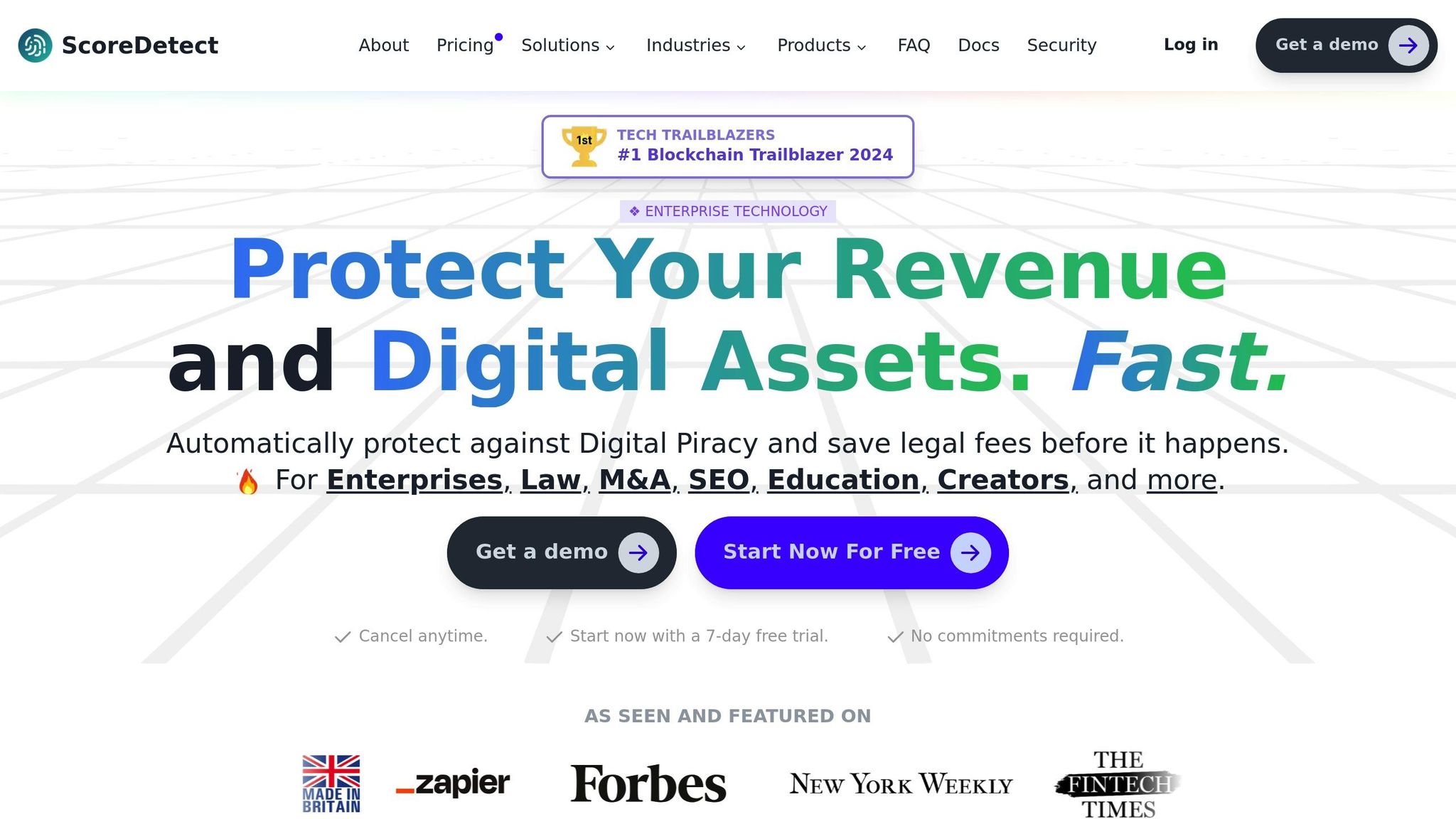Enterprise DRM helps businesses protect sensitive data, but it comes with challenges like complex authentication, compatibility issues, and performance bottlenecks. Here’s how to address these problems effectively:
- Authentication: Simplify access with biometrics, single sign-on (SSO), and multi-factor authentication (MFA).
- Compatibility: Ensure DRM works seamlessly across devices and platforms through regular updates.
- Scalability: Use cloud-based DRM to handle large content volumes and peak usage efficiently.
- Piracy Prevention: Employ advanced watermarking and tracking tools like ScoreDetect to trace and deter unauthorized sharing.
- Best Practices: Define clear protection rules, automate compliance tasks, and integrate DRM with existing systems for smoother workflows.
What is Enterprise Digital Rights Management (EDRM)?
Common Enterprise DRM Implementation Problems
When it comes to enterprise DRM (Digital Rights Management), large organizations often face a range of challenges that can slow down projects, inflate costs, and frustrate users. With 90% of organizations sharing sensitive content with over 1,000 third parties and 85% relying on four or more tools to manage this content [4], the technical environment becomes fragmented. This fragmentation introduces issues like complex authentication, compatibility headaches, and performance bottlenecks.
Complicated User Authentication Systems
One major hurdle is the complexity of DRM authentication processes, which can disrupt daily workflows. Requiring employees to navigate multiple verification steps or juggle numerous passwords not only slows them down but also creates frustration. If these systems don’t integrate with existing corporate login protocols, employees may have to manage separate credentials for DRM-protected resources. The result? Password fatigue, increased help desk calls, and risky workarounds that weaken overall security.
Striking the right balance between security and usability is key. Authentication systems should provide strong protection without making life unnecessarily difficult for legitimate users.
Cross-Platform Compatibility Issues
Enterprises rely on a mix of devices – Windows PCs, iOS tablets, Android smartphones, and a variety of browsers. Unfortunately, DRM systems often struggle to deliver consistent performance across this diverse ecosystem. This lack of compatibility can lead to security gaps and operational headaches [4]. For instance, content that works seamlessly on a desktop might fail to load on a mobile device, or certain features could be unavailable on specific operating systems.
These issues don’t just inconvenience employees – they can derail productivity, especially during critical moments like meetings. On top of that, efforts to maintain security across platforms sometimes degrade content quality, further eroding trust in the system [5]. Regular testing and updates are essential to ensure smooth, secure functionality across all devices.
Performance Problems with Large Content Volumes
Handling large amounts of content and managing thousands of simultaneous users is another area where DRM systems run into trouble. Performance issues are especially pronounced during high-demand events, such as company-wide training sessions or major product launches. A key bottleneck occurs during the process of obtaining video keys, which is essential for playback. Under heavy load, DRM request throughput can drop below 800 requests per second, even as concurrent streams skyrocket past 500,000 [6]. This mismatch creates chokepoints that disrupt service during critical moments.
Live events are particularly challenging. Unlike on-demand content, where requests are spread out, live events generate a surge of simultaneous access requests, which can lead to playback failures. If users experience interruptions, they may repeatedly attempt to reconnect, further overwhelming the system with retry floods [6]. Additionally, credential sharing – whether intentional or not – adds to the demand, causing service disruptions that can impact legitimate users [6].
How to Solve Enterprise DRM Problems
The challenges of enterprise DRM systems can feel overwhelming, but they’re far from unsolvable. With the right tools and strategies, businesses can transform clunky, frustrating DRM processes into efficient systems that protect content while keeping users happy. By adopting smarter authentication methods, utilizing cloud infrastructure, and improving content tracking, enterprises can strike the perfect balance between security and usability.
Smarter Authentication with Biometric and Advanced Methods
Biometric authentication offers a powerful layer of security, ensuring only the right people access protected content [7]. Beyond that, it helps reduce password fatigue – an issue that often leads to risky shortcuts and an increase in IT support requests.
Modern authentication solutions blend multiple approaches to create a seamless user experience. By integrating methods like biometric authentication, single sign-on (SSO), and multi-factor authentication (MFA), businesses can make accessing DRM-protected content easier and more secure [8]. For instance, SSO allows employees to use their existing corporate credentials to log in, while biometric verification adds an extra safeguard without burdening users with additional passwords.
AI takes things a step further by combining biometric data with behavior analysis to create unique user profiles. This reduces the risk of unauthorized access by identifying anomalies, such as unusual typing speeds or mouse movements [8]. Adaptive DRM systems use these insights to balance security with accessibility, ensuring users can work efficiently without compromising protection.
Cloud-Based DRM for Scalability and Efficiency
Switching to cloud-based DRM solutions addresses common performance and scalability issues. These platforms are designed to handle large volumes of content without slowing down [9]. As organizations grow their digital libraries and user bases, cloud-based systems can scale effortlessly to meet increasing demands.
Cloud infrastructure also ensures secure, global access to content. During peak usage periods, resources can be scaled automatically, reducing downtime and improving performance. This dynamic scalability not only enhances user experience but also helps cut operational costs [10].
Cloud-based DRM integrates easily into publishing workflows, making it ideal for managing expanding digital inventories. For example, the global eBook market is expected to grow by 1.62% annually between 2024 and 2027, reaching approximately $15.33 billion by 2027 [9]. With authentication streamlined and cloud performance optimized, the next step is to strengthen content protection through advanced tracking and watermarking.
Advanced Watermarking and Content Tracking with ScoreDetect

Once authentication and performance are in place, the focus shifts to preventing piracy and unauthorized distribution. While DRM protects content during transmission and access, digital watermarking adds another layer of defense. Watermarking embeds a unique identifier into content, linking it to a specific user or distributor. If piracy occurs, the watermark provides evidence for legal action [11].
The scale of piracy highlights the importance of these measures. In 2023, video piracy sites were visited 141 billion times – a 12% increase from 2019 [12]. In 2019 alone, TV and film piracy cost the industry between $29 billion and $71 billion annually. When illegal live sports streaming is factored in, losses can skyrocket to $229 billion [11].
Forensic watermarking is a game-changer. It’s invisible to users, ensuring a smooth viewing experience while making it nearly impossible for pirates to remove [14]. Modern watermarking solutions also include tools to quickly trace the source of unauthorized content.
This is where ScoreDetect excels. Its platform provides invisible, non-intrusive watermarking that integrates seamlessly with existing DRM systems. ScoreDetect’s AI-powered technology identifies unauthorized content with a 95% success rate, and its automated takedown system achieves a 96% success rate in removing flagged content through delisting notices [11].
ScoreDetect also uses blockchain technology to create a checksum of content, offering verifiable proof of ownership without storing the actual files. This ensures both privacy and legal protection for enterprises.
Dynamic watermarks add another layer of security by embedding user-specific information into content. These watermarks can trace unauthorized copies back to the original viewer, providing critical evidence for investigating breaches or unauthorized sharing [13]. This kind of tracking is invaluable for protecting digital assets and holding violators accountable.
sbb-itb-738ac1e
Best Practices for Enterprise DRM Setup
Setting up an effective DRM system requires clear policies, the smart use of automation, and smooth integration with existing systems. Companies that succeed in DRM focus on three main areas: establishing strong content protection rules, using automation to meet compliance requirements, and integrating DRM seamlessly into their workflows. These steps directly address common DRM challenges like policy precision, automation, and system compatibility.
Creating Clear Content Protection Rules
A solid DRM strategy begins with clearly defining what needs protection and how to protect it. Policies should align with business objectives, such as restricting playback to secure environments, blocking unauthorized recording tools, and ensuring compliance with licensing agreements [15]. Without well-defined rules, even the most advanced DRM system can fall short.
Start by identifying your most sensitive assets and determining the level of protection each one requires. Not all content needs the same level of security. For instance, internal training videos may only need basic access controls, while proprietary research documents might demand strong encryption and strict user restrictions.
Implement robust AES 256-bit encryption and create precise access rules, including start dates, expiration limits, open limits, print restrictions, and geographic controls [2]. For example, a media company might restrict content access to specific regions due to licensing agreements, whereas a financial institution might limit document access to certain departments.
It’s crucial to make these policies both thorough and practical. A successful DRM strategy involves regular monitoring, updates, and adjustments [15]. This ensures that your protection measures evolve alongside changing business needs and emerging security threats.
Using Automation for Regulatory Compliance
Automation plays a key role in reducing human error and ensuring consistency, particularly when dealing with regulations like GDPR, HIPAA, or SOX. Organizations that integrate automation into their workflows can improve data retention compliance rates by as much as 90% [17].
Modern DRM systems can automate tasks like data discovery, classification, and security enforcement [16]. By analyzing organizational data trends, these systems can automatically identify sensitive content and apply the right protection measures without human input.
The financial benefits are worth noting. Automation can cut operational costs by up to 30% and reduce human error by 85% [17]. For instance, a mid-sized healthcare provider that adopted automated retention systems was able to redirect savings into improving patient care.
ScoreDetect is a standout example of automation in action. Its platform can detect unauthorized content usage with a 95% success rate and issue takedown notices that achieve a 96% removal rate. With integrations to over 6,000 web apps via Zapier, the platform can set up automated workflows that handle compliance tasks with little to no manual oversight.
For organizations managing large volumes of content, automation is not optional – it’s essential. By 2025, 80% of data management tasks are expected to be automated [17]. Early adoption of these tools doesn’t just streamline operations; it provides a competitive edge.
Connecting DRM with Current Business Systems
The best DRM systems work behind the scenes, ensuring security without disrupting daily operations. DRM technologies should integrate directly into workflows, remaining invisible to authorized users [3]. This seamless approach ensures robust security without causing unnecessary friction.
Integrating DRM with ERP systems offers significant benefits. For example, ERP platforms can improve on-time deliveries by 24% and reduce operational costs by 23%, along with a 22% drop in administrative expenses [18]. When DRM tools are embedded into these systems, content protection becomes a natural extension of business operations rather than an added obstacle.
Choose DRM platforms that can adapt to different content formats, distribution methods, and access scenarios [3]. The goal is to create a scalable system that meets your current needs while accommodating future growth. DRM solutions should also integrate seamlessly with tools like content management systems, email platforms, and collaboration software to form a unified security framework.
User education is another critical piece of the puzzle. Organizations should educate employees about the importance of content protection and how DRM safeguards valuable assets from unauthorized sharing [3]. When users understand the purpose behind these measures, they’re more likely to support them rather than look for ways around them.
Conclusion: Creating a Strong DRM Plan
Establishing a clear DRM (Digital Rights Management) plan is crucial for any business navigating today’s digital landscape. To tackle the challenges of protecting content, an effective DRM strategy needs to focus on controlling access, managing usage, monitoring viewership, and preventing piracy – all while remaining adaptable to evolving threats [2].
A well-rounded DRM plan hinges on three key elements: technology that adapts to your needs, consistent monitoring, and employee buy-in. This is especially important considering that 90% of organizations share sensitive information with over 1,000 external parties [3][4]. Regular security assessments and updates to protocols are non-negotiable to stay ahead of potential vulnerabilities [3][1].
Getting users on board is equally critical. When employees understand that DRM measures are designed to safeguard the company’s assets, they’re more likely to embrace these practices [19].
Modern tools like ScoreDetect make implementing DRM strategies more seamless. With a 95% success rate in content discovery and 96% effectiveness in takedowns, it integrates effortlessly with over 6,000 web apps via Zapier, streamlining workflows and boosting efficiency.
"ScoreDetect is exactly what you need to protect your intellectual property in this age of hyper-digitization. Truly an innovative product, I highly recommend it!" – Imri, Startup SaaS, CEO [20]
Beyond protecting intellectual property, tools like ScoreDetect enhance verifiable ownership and strengthen your overall content protection framework [20].
With advanced features like enhanced authentication, scalable cloud solutions, and cutting-edge watermarking, a comprehensive DRM system does more than just secure your digital assets – it becomes a foundation for growth. By planning proactively, staying adaptable, and choosing the right tools, businesses can turn DRM into a strategic advantage, ensuring their content remains protected while driving innovation [3].
FAQs
How can enterprises simplify DRM authentication without compromising security?
Enterprises can make DRM authentication more straightforward while keeping security intact by using approaches like single sign-on (SSO) and adaptive authentication.
With SSO, users only need to log in once to gain access to multiple resources securely. This eliminates the need to juggle multiple passwords, making workflows smoother and improving the overall user experience – all without compromising security.
On the other hand, adaptive authentication takes protection a step further by evaluating user behavior and context. For instance, in typical scenarios, users can log in effortlessly. However, if something out of the ordinary is detected – like a login attempt from an unusual location – extra verification steps kick in. Together, these methods offer a balance of convenience and strong security for enterprise DRM systems.
How can enterprises make sure their DRM systems work seamlessly across different devices and platforms?
To ensure smooth integration of DRM systems across different devices and platforms, businesses should adopt a multi-DRM strategy. This means supporting popular standards like Widevine for Android and FairPlay for iOS, which allows for secure content delivery while keeping access user-friendly.
It’s also important to categorize content based on its security needs and apply specific protection techniques, such as encryption and watermarking, to safeguard valuable digital assets. Additionally, keeping DRM systems up-to-date and regularly testing them ensures they remain compatible with new devices and platforms, maintaining both security and performance.
How does cloud-based DRM improve scalability and efficiency for large organizations?
Cloud-based DRM takes scalability and efficiency to the next level by providing on-demand access to digital assets without the need for heavy on-site infrastructure. This means businesses can easily adjust their operations to match demand, cut down on hardware upkeep costs, and ensure smooth access across various devices and locations.
On top of that, it automates tasks like content protection and monitoring, simplifying workflows and boosting productivity. This not only saves valuable time but also delivers strong security for digital assets in today’s fast-moving, interconnected world.

